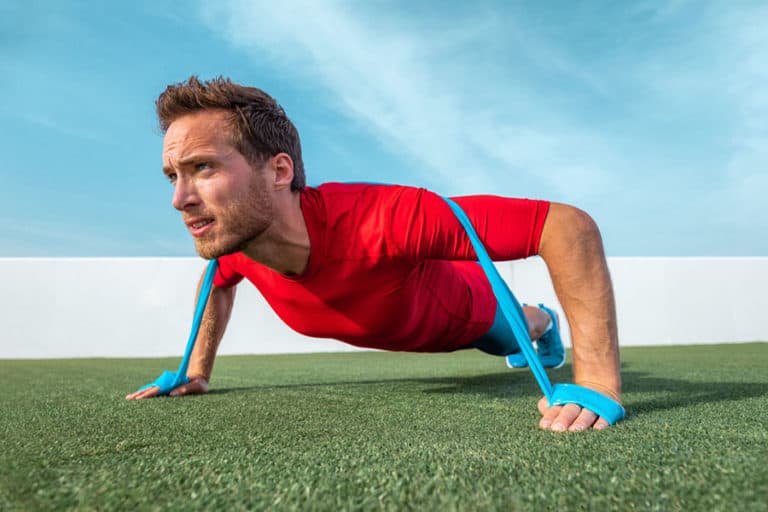How Many Pushups Should I Do a Day? Types, Benefits, Tips

How many push-ups should I do a day? Well, here are the answers to that and all your push-up-related questions and doubts. A complete push-up plan showing how many push-ups you should do a day to build upper body muscles, fix posture and improve overall health.
Pushups are arguably the most popular bodyweight exercises and a great addition to any exercise program. The popularity of push-ups stems primarily from how easy and convenient they are. All you need is some floor space and your body weight, and you’re good to go.
There are numerous variations of the push-up, with differing complexities and effectiveness. While most of these variations work the same muscles, some target specific muscle groups more than others.
One might wonder if a specific number of push-ups would yield optimum results if done daily. Some may ask, “How many push-ups should I do a day?” Or, “How many push-ups should I be able to do?”
This is why this article hopes to examine the different types of push-ups available, their benefits, and other tips for the best results.
How many pushups should I do a day?
Doing push-ups daily without proper guidance can strain the arm muscles (triceps). Recent studies [1]Canada College: Step 2: Assess Your Fitness Level have shown that men and women at certain ages should be able to do an average number of push-ups depending on their ages. For clarity, the table below illustrates how many push-ups you should be able to do:
Table showing the average number of push-ups
| Sex/Ages | 15-19 years | 20-29 years | 30-39 years | 40-49 years | 50-59 years | 60+ |
| Men | 23-28 Push-ups | 22-28 Push-ups | 17-21 Push-ups | 13-16 Push-ups | 10-12 Push-ups | 8-10 Push-ups |
| Women | 18-24 Push-ups | 15-20 Push-ups | 13-19 Push-ups | 11-14 Push-ups | 7-10 Push-ups | 5-11 Push-ups |
How to do push-ups the right way?
The benefits of pushups [2]ResearchGate: The Push –up are numerous. They increase stamina, enhance core strength, improve cardiovascular health, and fix posture. However, to maximize these benefits and avoid injuries, it is important to do them with the correct form and movement.
The principle behind executing a proper push-up is simple. Despite the different known variations, the sequence of movements is similar and the muscles targeted are usually the same.
Executing a regular push-up will involve the following elemental movements:
- Getting down on all fours, stretching your legs, and propping your body up in a straight line with your arms.
- Placing your hands shoulder-width apart (you may need to place them slightly wider or narrower than that for many variants).
- Push your body up with your arms.
- Slowly lower your body.
- Repeat the sequence by pushing up and lowering your body.
- Start slow, with fewer reps to avoid any muscle injury or strain, and gradually increase the number of reps and speed as you go along.
9 types of push-ups
Push-ups have quite a few variations. Each of them provides varying levels of difficulty. The variations incorporate other muscles apart from the chest muscles and the triceps. Listed below are some of the well-known and easy-to-perform push-up types:
1. Basic push-ups
Target muscles: Triceps, pectoral muscles, and shoulders
Basic push-ups are an excellent bodyweight exercise to build upper body strength. When done with proper form, they can also strengthen the lower back and core by engaging the abdominal muscles. Regular push-ups engage the core muscles, tone the arms and even build muscle. They are so simple and convenient that they can be done almost anywhere.
To execute
- Get down on all fours, keep your body in a straight line, and place your hands slightly wider than shoulder-width apart.
- Keeping your core engaged, inhale as you bend your elbows and lower your body.
- Hold this position for a second or two.
- Exhale and use your arms to push your body slowly back to your starting position.
- Repeat.
2. Wide arm push-up
Target muscles: Pectoralis, anterior deltoid, triceps
Second on the list is the wide-arm push-up. This type of push-up workout focuses on the pectoral muscles.
To execute
- Start in the conventional push-up position
- Stretch your arms further apart(up to 2-3 feet)
- Lower your body, pause, and lift back up
- Repeat this sequence.
3. Incline push-ups
Target muscles: Pectoral muscles, triceps, and chest
Incline push-up is a great alternative to traditional push-ups for several reasons. They take pressure off the shoulders, wrists, and elbows and emphasize the chest muscles most. This makes the incline push-ups a good choice for those with joint issues.
To execute
- Place your hands on an elevated surface, like the edge of a bench or table.
- Align your feet and keep your body straight.
- Slowly bend your elbows to lower your chest to the edge of the bench.
- Push back up until your elbows are extended but not locked.
4. Decline push-up
Target muscles: Triceps, anterior deltoids, pectorals, and the serratus anterior muscle under your arm
Decline pushups are a great way to work your upper pecs and the muscles in your shoulders. In this variant, both your feet are placed on an elevated surface in a position higher than your head. This creates more resistance and makes the exercise more challenging. If you’re new to decline pushups, start with a low surface, like a curb or step. You can increase the height over time.
To execute
- Put your hands on the floor, shoulders over your wrists, and elbows at 45 degrees.
- Place your feet on top of a bench.
- Brace your core, glutes, and quads, straighten your elbows and push your chest up, keeping your back and neck straight.
- Slowly push down to the floor again, and repeat.
5. Plyo push-up
Target muscles: Chest, triceps, abs, and shoulders
Plyo push-ups are a type of plyometric exercise that provides several benefits, including good calorie burn, lower body fat, and better cardiovascular fitness. Plyo push-ups are a great way to train your upper body and improve your overall fitness level, and they also help activate fast-twitch muscle fibers and engender increased power.
To execute
- Start in a standard push-up position with your palms on the ground.
- Bend your elbows and lower your body until your chest is just above the ground.
- From there, explode upwards and lift your hands off the ground.
- As you jump up, clap your hands together before returning to the starting position.
6. Diamond push-ups
Target muscles: Triceps brachii, pectoralis major, and deltoids
The diamond push-up got its name from the diamond shape the hands make by bringing together the thumb and the pointing finger. This push-up works to strengthen your core and your triceps.
To execute
- Start in a plank position and slowly bring your hands together. Focus on your balance as you do this.
- Let your index finger and thumb touch each other to form the shape of a triangle/diamond shape.
- Slowly elevate your upper body
- Lower your body, pause, and elevate again.
7. Archer push-up
Target muscles: Anterior deltoid, pectoral muscles, and triceps brachii
It is possible to get tired of the aforementioned push-up routines after a while because they are easy to execute and not too challenging. The archer push-up, on the other hand, is a different beast. It is pretty challenging to perform but comes with good rewards.
To execute
- Begin in the standard push-up position.
- As you lower your body, tilt your body completely to the right or left so that your entire body weight rests on one arm.
- Lift your body back up.
- Repeat the motion for your other arm.
8. Staggered hands push-up
Target muscles: Triceps, biceps, chest, shoulders, and abs
The staggered hands push-up is another variation worthy of note. It works on the muscles of the upper body and the core. Moreover, you’d discover that it is easy to execute and suitable for beginners.
To execute
- Start in the normal push stance with your arms apart.
- Move one hand forward and the other backward. Let your hands be offset by about 6-12 inches apart.
- Lower your body and elevate again.
- Alternate the position of your hands after each repetition.
9. Sidekick push-up
Target muscles: Obliques and core
Last on the list is the sidekick push-up. This variation works on your core alongside building your upper body muscles.
To execute
- Begin in the conventional push-up stance.
- Holding your body up with your arms, slowly lower down.
- With your body lowered, bring forward your left leg.
- Stop when your left leg touches your elbow.
- Return back to your original position.
- Repeat the process with your right leg.
Sample push-up workout plan
| Days | Push-ups |
| Monday | Basic push up – 15 reps Wide arm – 10 reps |
| Tuesday | Decline – 15 reps Plyo push up – 5 reps each leg |
| Wednesday | Staggered hands – 10 reps Archer push up – 5 reps each arm |
| Thursday | Diamond – 15 reps Sidekick push up – 5 reps each leg |
| Friday | Inclined – 15 reps Plyo push up – 5 reps each leg |
| Saturday | Rest |
| Sunday | Rest |
What muscles do push-ups work?
To answer the question “what muscles do push-ups work? ” one must factor in the different variations. Regardless of the type of push-up being examined, the upper body’s muscles are always affected.
But more precisely, push-ups work on the pectoral muscles of the chest and the triceps. Some may also help strengthen your core and your back muscles.
Benefits of pushups
While many think that pushups are only for the upper body, they actually work multiple muscle groups in your body, including your chest, shoulders, triceps, and core muscles. There are many benefits of doing push-ups daily, but the more important ones are listed below:
1. Improves overall fitness level
Push-ups require high levels of endurance. Endurance increases your pain threshold. This allows you to last longer without a drop in performance, thereby improving your fitness level.
2. Works several muscles at once
Push-ups work on different muscles of the body, thus increasing overall muscle strength. The chest muscles, triceps, biceps, back muscles, and core benefit from the regular performance of push-ups. Studies [3]National Library of Medicine: Selective Activation of Shoulder, Trunk, and Arm Muscles: A Comparative Analysis of Different Push-Up Variants have proven that some variants of push-ups improve the health of the above muscles and the nerve cells that control them.
3. Strengthens joints and bones
Push-ups help in building the supportive structures of your body. The different ranges of movement ensure that the bones and joints partaking in this movement are strong and flexible, respectively.
4. Burns calories
To correctly execute a push-up workout routine, you will require a lot of strength and energy. The more energy you dissipate in the workout sequence, the more calories you will burn.
5. Improves cardiovascular health
Push-ups are a great cardio boost since they push the heart rate up and help maintain cardiovascular [4]National Library of Medicine: Association Between Push-up Exercise Capacity and Future Cardiovascular Events Among Active Adult Men health. The increase in the heart rate is your body’s way of increasing metabolism so that more energy is released to carry out the push-up.
6. Improves posture
Sitting for long periods takes its toll on your posture. A push-up workout routine is one of the many ways you can correct a faulty posture. It works on the upper back muscles to give a firm, erect, and stronger back.
Can you do push-ups every day?
The answer to this is a straightforward yes. Consistency is the key to enjoying the benefits of any exercise routine. Basic, full push-ups are easy to execute. As a result, they encourage consistency. Doing push-ups every day speeds up the muscle-building process, giving you the body you desire in no time.
Avoiding over-exertion
Over-exertion happens when you push your body beyond its limits. While it is admirable to desire a fit and well-toned muscular structure, you must avoid overdoing it. Muscle soreness, strain, and injury from a workout can cause pain, inflammation, and discomfort.
Moreover, over-exertion may result from improper posture or carrying too much weight. Here are a few tips to avoid overexertion:
- Warm up before beginning your push-up routine.
- Take breaks in between every sequence.
- Know your limits and seek guidance on how many push-ups you can execute with your level of fitness.
- Use a foam roller to massage your muscles after the workout sequence.
Tips and precautions
For proper execution of the push-up and quick results, here are a few tips and precautions to keep in mind:
- Maintain good form throughout the execution.
- Always engage your core.
- Elevate and release your body in a controlled way.
- Do not lock your elbows.
- Align your head and neck with your spine.
- Understand the correct placement of your hands to avoid elbow or wrist injury.
- Do a bit of cardio before you start the push-up routine to get yourself warmed up and your heart pumping.
Conclusion
Push-ups are very beneficial forms of calisthenics. However, the rewards they carry go to only those who are consistent in execution. If you want great results from this type of exercise, then it’s best to begin immediately, formulate a plan, and stick to it.
It is always a good idea to seek the help of a certified fitness trainer to guide you through your workout. If you wish to start doing push-ups regularly, we suggest starting from the simpler ones and working your way up to the difficult ones. Set yourself a workable push-up challenge every week and build your strength and fitness as you go along.
References
| ↑1 | Canada College: Step 2: Assess Your Fitness Level |
|---|---|
| ↑2 | ResearchGate: The Push –up |
| ↑3 | National Library of Medicine: Selective Activation of Shoulder, Trunk, and Arm Muscles: A Comparative Analysis of Different Push-Up Variants |
| ↑4 | National Library of Medicine: Association Between Push-up Exercise Capacity and Future Cardiovascular Events Among Active Adult Men |







